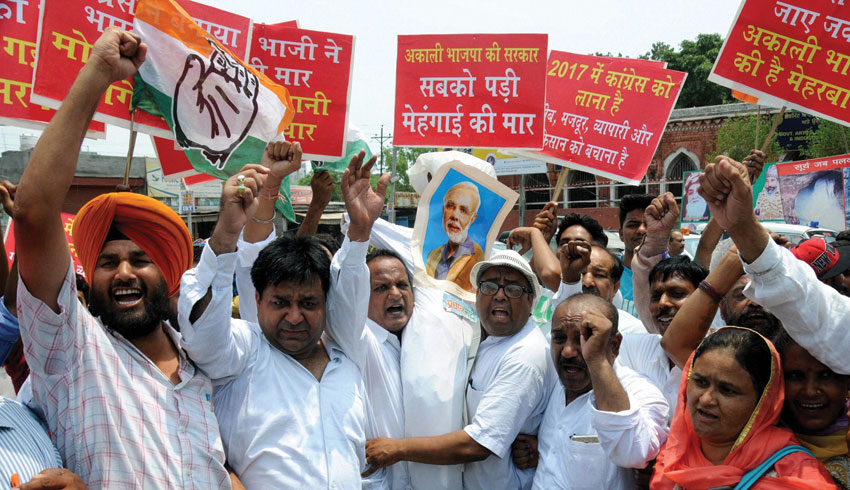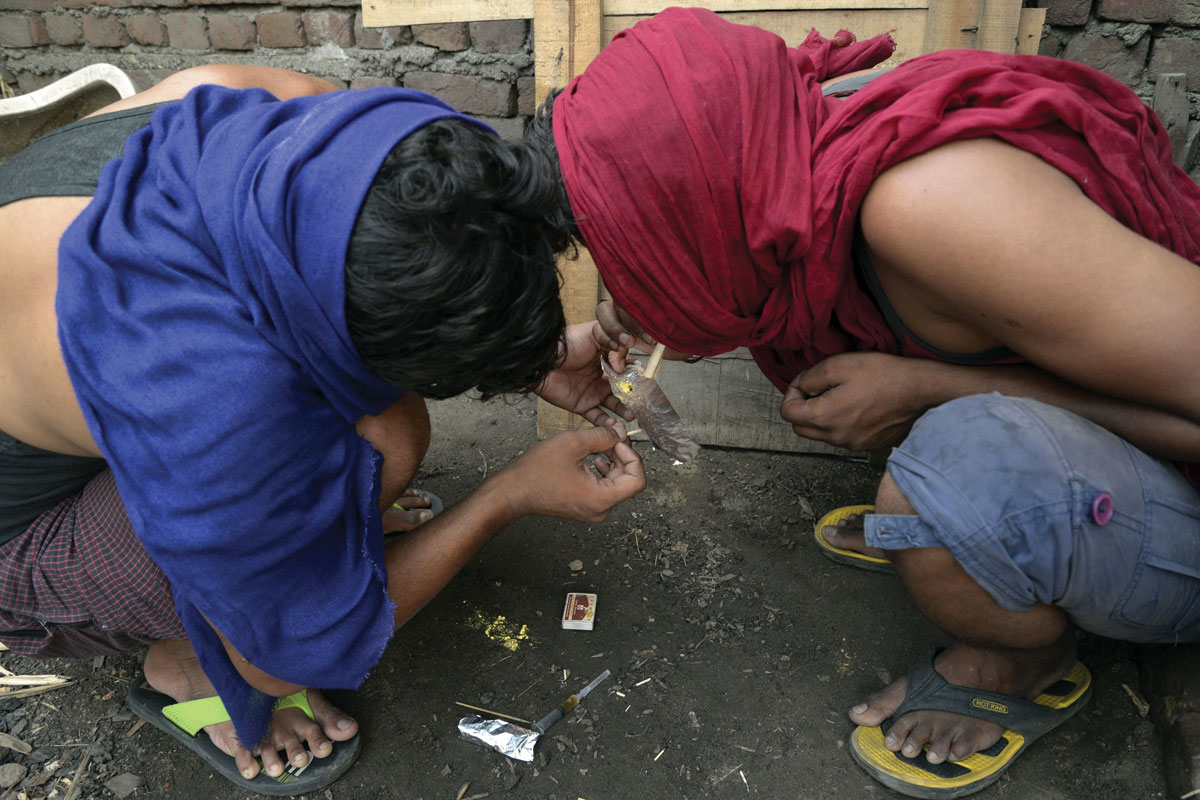FROM A BREAD BASKET TO AN OPIUM CHALICE?
Indian youth inhale drugs on the outskirts of Jalandhar in the north-western Punjab, June 15. (Shammi Mehra | AFP | Getty Images)
India and especially the northern state of Punjab that was once at the forefront of the successful Green Revolution, is in big denial — that it has a drug problem, writes Priyanka Bhardwaj. – @siliconeer #siliconeer #punjab #drughaven #india #indianyouth #society
According to the 2015 survey conducted by the Society for Promotion of Youth & Masses, an NGO, in collaboration with the National Drug Dependence Treatment Center, All India Institute of Medical Sciences, of the 27.5 million population of Punjab approximately 230,000 are opioid (heroin, opium, doda, phukki) dependent people and four times as many opioid users whose annual expenditure on such substances is roughly Rs. 75.75 billion.
The study was based on just one type of drug—opioids, products of the opium plant, such as heroin and morphine, or synthetic drugs that impact the human body like opium.
Among a whole lot of startling findings the crucial ones are that –76% of the opioid users are in the age group of 18 to 35 years, 89% are literate, 99% are males, 56% are from rural areas and 90% users inject themselves with heroin.
About 0.84% of its population are drug dependents as compared to the national figure that stands at 0.25% (Ministry of Social Justice & Empowerment estimates 3 million users nationwide).
Also that heroin, a highly processed and more addictive form of opium, is the drug of choice for the addicts who were earlier hooked on to opium or pharmaceutical opioids.
The need to scrutinize this survey became paramount in the wake of the recent controversy surrounding the release of the recent Bollywood flick, “Udta Punjab” starring Shahid Kapoor, Alia Bhatt and Kareena Kapoor Khan.
The censor board under political pressure failingly argued that the movie portrayed the Punjab youth in a derogatory light till the High Court ruled its release.
It must be to do with the early 2017 state assembly polls that the Shiromani Akali Dal and Bharatiya Janata Party (BJP) ruling combine opposed the release tooth and nail as any admittance would accrue to allusions of either state complicity or at best its inability to counter the ill.
This is not the first time that drug menace has become a pre-election topic.
During the last (2011) Punjab assembly elections, Rahul Gandhi, President of the Indian National Congress’ mention of the problem and quoting of a statistical number (though inaccurate) had turned into an instrument of political attack, without really addressing any anomalies and eventually a quick burial of the issue.
Vijay Sampla, Punjab’s Social and Justice Empowerment Minister who has been entrusted with the presidentship of the state BJP unit in forthcoming elections denounced and rejected the 2015 survey contending that rave parties are a common affair in Delhi, Mumbai, Goa and Himachal Pradesh, but not in Punjab.

In defense of the AIIMS study, its prime author, Dr. Atul Ambekar asserts, “The AIIMS report is the first ever study of its kind in Punjab which provides an estimation of the size of opioid dependent population in the entire state, using a scientifically valid and time-tested methodology. The data was collected from 3,620 people across 10 districts that represent 60% of Punjab’s population. All of these were opioid addicts and not those who consume alcohol. In fact the same methodology was used by AIIMS to conduct two UN-commissioned studies: a 2007 study on the injecting-drug users in Punjab and a more recent one on drug abuse in Malé, Maldives.”
The report states that 80% of those surveyed tried to give up drug use but only 35% received any kind of help including from NGOs and religious groups and also that 16% of these received medical treatment while 8% got in-patient treatment or were admitted to de-addiction centers.
“We found most of the opioid users under-served as adequate treatment services were unavailable. An average de-addiction center catered to just 250 people in one year. Even if we open hundred such centers, it will serve only 25,000 addicts a year. At this rate, it will take 10 years to just admit all of the 2.5 lakh addicts even for a few weeks whereas most people relapse,” informs Ambekar.
Last year, on International Drugs Day, June 26, the state sanctioned 26 new de-addiction centers but if these will have provisions for opioid substitution treatments, considered most effective, is not known.
Currently centers providing substitution treatment are not run by central government through National AIDS Control Organization that focuses only on injecting drug users and not all opioid users.
With just about 30% addicts injecting drugs, a huge majority is left out of the scope of treatment.
Thus an entire generation lives under a haze of drugs in countless towns and villages such as Maqboolpura village, infamously named “village of widows” as each family has lost a member to drugs.
Taking cognizance of this fact, social groups have started organizing nukkad or street theatre, plays and seminars to spread the anti-drug message and in Maqboolpura itself, an ordinary school teacher, Ajit Singh has resolved to turn the “village of widows” to a “village of scholars” by imparting free education to orphans of drug victims.
In order to paint a picture of good and proactive government the Punjab authorities may claim to have disrupted the drug network with global links with its arrest of 27,000 drug peddlers including 145 kingpins since the launch of its “operation clean” (2014).
But a look at these First Information Reports reveals drastic fudging up of data.
Also that small or intermediate quantities of narcotics were seized in each arrest testifies to the fact that the crackdown was aimed at petty drug peddlers and consumers who possessed 5 grams or less of cocaine and not some big fish such as a major link in the drug network, involved politicians or businessmen.
Former Punjab DG (Prisons), Sashi Kant comments, “The police was on a spree to nab the poor drug addicts to please their political bosses. The confessional statements of three people – former Punjab cop Jagdish Singh Bhola, Akali Dal leader Bittu Aulakh and synthetic drug supplier Jagjit Singh Chahal had clearly indicated that Punjab cabinet minister Bikramjit Singh Majithia had links with international drug smugglers but no action was taken against him as he was Badal’s relative.”
Sources allege that despite their arrests, addicts have been procuring drugs in jails too.
Historically speaking, Northern India has always had a recreational association with “afeem” (opium) and elders often advised young mothers to use slight amounts to put a constantly wailing toddler to sleep!
But for narcotics to become a flourishing bane the mix of demand, supply and ample moolah, on account of enormous remittances and green revolution, provided the optimum climate aided by prevalence of unemployment, economic stagnancy, apathetic government, very few and ineffective rehabilitation institutions.
Starting from being a mere transit point in the dreadful Golden Crescent drug trafficking route, for the opium grown in Iran and Afghanistan, Punjab turned into a big market of consumers and it is literally a child’s play to procure narcotics in any part of its capital town, or village.


